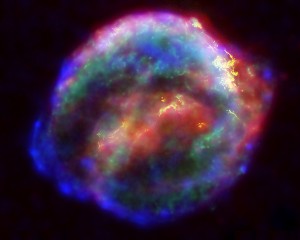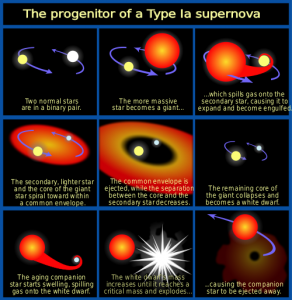Type Ia supernovae are “standard candles” with which we measure the universe. We can use them for this purpose because they appear to have definite light curves – that is, their luminosity decreases with time at a predictable rate. Since time and distance are generally interchangeable when dealing with stellar phenomena (both are governed by the speed of light – if we see something happening one light year away, it’s happening one year in the past), we know that the dimmer a Type Ia supernova is, the further away it is, and we can get the particular distance.
Why do Type Ia supernovae have this quality when other supernovae don’t? It’s because of the way they’re formed. They start off as a binary star system with a stable white dwarf star at the center. Over time, the central star accumulates material from its companion star through gravity, and approaches the Chandrasekhar limit – the maximum size a white dwarf can reach without collapsing – which is around 1.4 times the mass of our Sun. Since the supernova occurs right when the white dwarf reaches this limit, the nature of the collapse is pretty close to exact. Here’s a diagram from NASA to illustrate some of the particulars:
But while this overall picture is accepted, some questions remain: does the white dwarf actually reach the limit, or does it collapse before that? We see an envelope of gas being released by the pair in the center phase of the diagram above – does that always happen? If not, how might that difference change our view of the use of type Ia supernovae as standard candles?
Well, research from the Harvard-Smithsonian Center for Astrophysics, which you can read about here, takes on the problem of the envelope of ejected gas. In a study of 23 Type Ia supernovae, the conclusion was that systems with outflows of gas tend to have more powerful explosions, and they only make up a small fraction of the total. That means, when using these supernovae as standard candles, we may have a bit of fine-tuning to do. The gift that the universe has provided in the form of these bright spots will probably turn out to be more complicated than we first thought.
On the other hand, maybe this discovery might actually solve some lingering mysteries that were actually a result of the faulty assumption that all Type Ia supernovae are the same.

